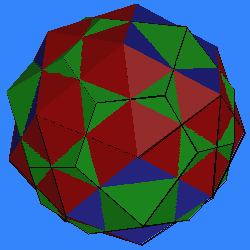Archimedean Duals
In the Archimedean duals, every face is identical but there are two or more different types of vertices. This is because in the original Archimedean solids every vertex is identical but there are two or more different types of faces, and when taking the dual, faces transform into vertices and vice versa. In these Archimedean duals, the faces are not regular polygons; there are different lengths and angles within each face, but each face is identical and the vertex figures are regular. Furthermore, from the construction it follows that all the dihedral angles of an Archimedean dual are equal.
 The
relationships between the Archimedean solids and their respective duals
is nicely brought out by studying a compound of a solid and its dual. For
example, the snub cube and its
dual, the pentagonal icositetrahedron,
combine into this beautiful compound.
The five-sided faces of the dual correspond to the fact that five polygons
(four triangles and a square) meet at each vertex of the snub cube. (By
the way, be sure and take a peek into the inside of this object.)
The
relationships between the Archimedean solids and their respective duals
is nicely brought out by studying a compound of a solid and its dual. For
example, the snub cube and its
dual, the pentagonal icositetrahedron,
combine into this beautiful compound.
The five-sided faces of the dual correspond to the fact that five polygons
(four triangles and a square) meet at each vertex of the snub cube. (By
the way, be sure and take a peek into the inside of this object.)
Check out this list of all thirteen Archimedean duals and compounds. In each compound note how the vertices of each solid are over the centers of the faces of the other. Also observe that a polyhedron and its dual have the same number of edges. The edges cross at right angles at a point which is the midpoint of the Archimedean solid's edge, but not always the midpoint of the dual solid's edge.
The above list also includes an image of the face of each archimedean dual. This is handy if you want to make a paper model of an archimedean dual. Simply print out the face and use it as a template.
Exercise: Which Archimedean duals are chiral ?
Answer: Only this one and this one.